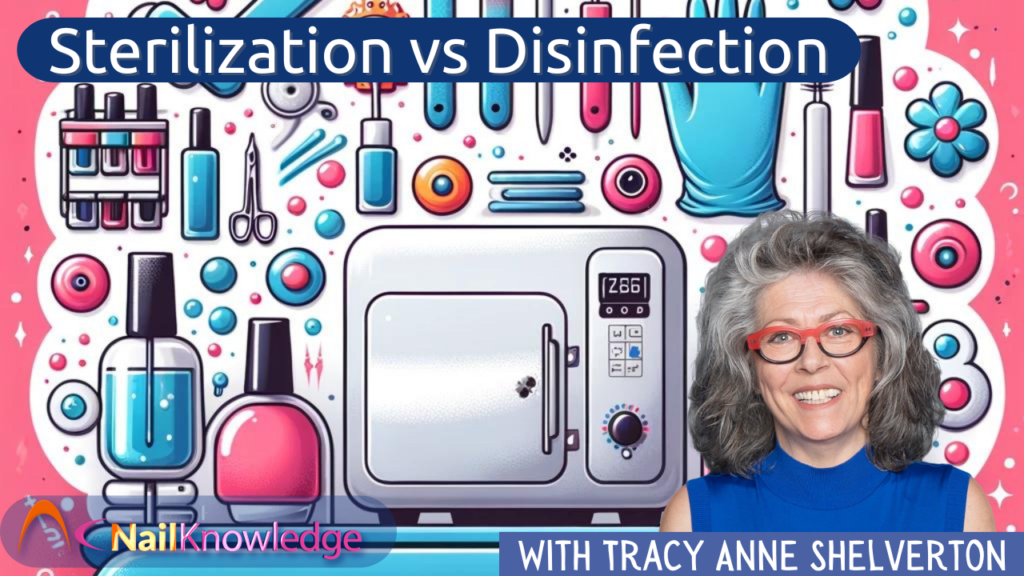In the nail industry, maintaining a clean and safe environment is crucial for the well-being of both clients and technicians. One of the most important aspects of this is understanding the difference between sterilization and disinfection. While both processes are essential, they serve different purposes in ensuring hygiene. Sterilization involves the complete removal or killing of all viable organisms, including spores, while disinfection reduces the number of microorganisms but may not eliminate them entirely.
Chúng tôi sẽ tìm hiểu sâu hơn về các quy trình này, cùng với các mẹo thực tế để giữ cho dụng cụ, bề mặt làm việc và vệ sinh cá nhân của bạn ở tiêu chuẩn cao nhất nhằm đảm bảo an toàn cho khách hàng, đặc biệt là những người có hệ thống miễn dịch yếu.
Sự khác biệt giữa tiệt trùng và khử trùng
- Vệ sinh & Khử trùng: This process removes dirt, dust, and organic matter while killing most microorganisms. However, it doesn’t remove them entirely.
- Khử trùng:Phương pháp này tiêu diệt tất cả các sinh vật, bao gồm cả bào tử, đảm bảo mức độ sạch sẽ cao nhất. Mặc dù các sinh vật chết và độc tố (pyrogen) có thể vẫn còn, nhưng nguy cơ nhiễm trùng đã được loại bỏ.
Tại sao vệ sinh đúng cách lại quan trọng trong việc chăm sóc móng tay
Nail professionals may unintentionally transfer infections through contact with tools, hands, or the air. This can be particularly dangerous for clients undergoing chemotherapy or those with weakened immune systems. Maintaining personal hygiene, wearing appropriate clothing, and keeping workspaces clean is essential in reducing this risk.
Rửa tay và khử trùng
Vệ sinh tay là một trong những cách đơn giản nhất nhưng hiệu quả nhất để bảo vệ bạn và khách hàng:
- Xà phòng và nước: Rửa tay with soap and water removes about 96% of pathogens. Make sure both you and your client wash your hands before starting any nail service.
- Khử trùng tay: Trong khi chất khử trùng tay loại bỏ một số vi khuẩn tạm thời và một số vi khuẩn thường trú vi khuẩn, they don’t clean dirt or grease. Use disinfection products in addition to washing your hands.
Khi nào cần rửa và khử trùng tay
- Before every treatment, even if the client’s skin is intact.
- Khi thực hiện các thủ thuật liên quan đến việc phá vỡ hàng rào bảo vệ da.
- Sau khi tháo găng tay, tiếp xúc vật lý với vùng da bị trầy xước hoặc kiểm tra bàn chân hoặc bàn tay.
Khử trùng và vệ sinh dụng cụ cho thợ làm móng chuyên nghiệp
Không giống như bệnh viện nơi các dụng cụ được khử trùng cho mọi quy trình, tiệm làm móng cần phải chịu trách nhiệm về quy trình vệ sinh và khử trùng của riêng mình:
- Công cụ vệ sinh: Tools should be washed with soap and water, then soaked in a cleaning fluid specific to your country’s regulations.
- Khử trùng: If possible, use an autoclave to sterilize tools and efile bits. Autoclaves sterilize using high temperatures and pressure, ensuring tools are safe to use for every client. Modern autoclaves are now more affordable and efficient, making them a viable option for nail salons. Remember to wash the tools with soap and water first as this also removes normal debris accumulated during the nail service.
Suy nghĩ cuối cùng: Tầm quan trọng của việc khử nhiễm
Decontamination is the ultimate step in ensuring the complete safety of tools, workspaces, and environments by eliminating all microbial contamination. Following strict hygiene practices, sterilization, and disinfection protocols not only protects your clients but also upholds the professional standards of your salon.
Bằng cách thực hiện những biện pháp này, các chuyên gia làm móng có thể cung cấp dịch vụ an toàn hơn, đồng thời thúc đẩy môi trường sạch sẽ, vô trùng trong tiệm.


